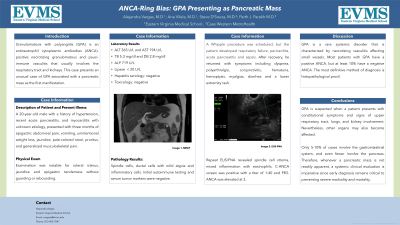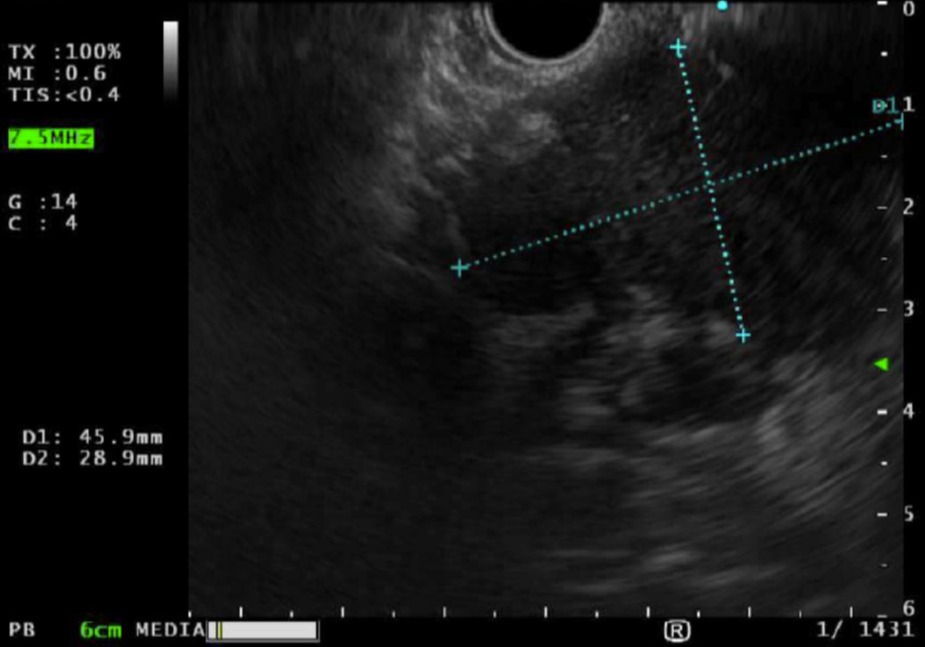Tuesday Poster Session
Category: Biliary/Pancreas
P2924 - ANCA-Ring Bias: GPA Presenting as Pancreatic Mass
Tuesday, October 24, 2023
10:30 AM - 4:00 PM PT
Location: Exhibit Hall

Has Audio

Alejandra Vargas, MD
Eastern Virginia Medical School
Norfolk, VA
Presenting Author(s)
Alejandra Vargas, MD, Ana Rosa Vilela Sangay, MD, Steve D'Souza, MD, Parth Parekh, MD
Eastern Virginia Medical School, Norfolk, VA
Introduction: Granulomatosis with polyangiitis (GPA) is an antineutrophil cytoplasmic antibodies (ANCA)-positive necrotizing granulomatous and pauci-immune vasculitis, typically affecting the respiratory tract and kidneys. This case presents an unusual case of GPA associated with a pancreatic mass.
Case Description/Methods: A 20-year-old male with a history of gastroesophageal reflux disease, hypertension, idiopathic acute pancreatitis, and myocarditis, presented with three months of epigastric pain, vomiting, weight loss, jaundice, pale stools, pruritus, and musculoskeletal pain. Examination showed jaundice and epigastric tenderness. Workup revealed transaminitis, elevated bilirubin and normal lipase. Imaging revealed common bile duct dilation with an obstructing lesion at pancreatic head. The patient underwent endoscopic retrograde cholangiopancreatography (ERCP) with biliary stenting, and endoscopic ultrasound and fine-needle aspiration (EUS-FNA) with cytology, showing atypical cells and mixed inflammation. Autoimmune testing and tumor markers were negative. Repeat EUS-FNA results were similar.
A Whipple procedure was planned, but the patient had worsening abdominal pain, and pleuritic chest pain. Imaging demonstrated pericardial and pleural effusions. He was treated with NSAIDs, colchicine, and antibiotics with clinical improvement. Thirteen days later, he presented again with dyspnea, polyarthralgias, conjunctivitis, hematuria, hemoptysis, night sweats, myalgias, diarrhea and a lower extremity rash. Skin biopsy revealed leukocytoclastic vasculitis, and EUS/FNA revealed spindle cell stroma, mixed inflammation with eosinophils. Proteinase-3 anti-neutrophilic cytoplasmic antibody (PR3-ANCA) was elevated. He was treated with steroids, Rituximab, and Tixagevinab/Cilgavimab with resolution of his symptoms.
Discussion: GPA is a rare disorder characterized by necrotizing vasculitis affecting small vessels. Most patients with GPA have a positive ANCA, but at least 10% have a negative ANCA, making diagnosis difficult. GPA is suspected with constitutional symptoms and signs of respiratory tract, and kidney involvement. Only 5-10% of cases involve the gastrointestinal system, and even fewer involve the pancreas. Therefore, whenever a pancreatic mass is not readily apparent, a systemic clinical evaluation is imperative since early diagnosis remains critical to preventing severe morbidity and mortality.

Disclosures:
Alejandra Vargas, MD, Ana Rosa Vilela Sangay, MD, Steve D'Souza, MD, Parth Parekh, MD. P2924 - ANCA-Ring Bias: GPA Presenting as Pancreatic Mass, ACG 2023 Annual Scientific Meeting Abstracts. Vancouver, BC, Canada: American College of Gastroenterology.
Eastern Virginia Medical School, Norfolk, VA
Introduction: Granulomatosis with polyangiitis (GPA) is an antineutrophil cytoplasmic antibodies (ANCA)-positive necrotizing granulomatous and pauci-immune vasculitis, typically affecting the respiratory tract and kidneys. This case presents an unusual case of GPA associated with a pancreatic mass.
Case Description/Methods: A 20-year-old male with a history of gastroesophageal reflux disease, hypertension, idiopathic acute pancreatitis, and myocarditis, presented with three months of epigastric pain, vomiting, weight loss, jaundice, pale stools, pruritus, and musculoskeletal pain. Examination showed jaundice and epigastric tenderness. Workup revealed transaminitis, elevated bilirubin and normal lipase. Imaging revealed common bile duct dilation with an obstructing lesion at pancreatic head. The patient underwent endoscopic retrograde cholangiopancreatography (ERCP) with biliary stenting, and endoscopic ultrasound and fine-needle aspiration (EUS-FNA) with cytology, showing atypical cells and mixed inflammation. Autoimmune testing and tumor markers were negative. Repeat EUS-FNA results were similar.
A Whipple procedure was planned, but the patient had worsening abdominal pain, and pleuritic chest pain. Imaging demonstrated pericardial and pleural effusions. He was treated with NSAIDs, colchicine, and antibiotics with clinical improvement. Thirteen days later, he presented again with dyspnea, polyarthralgias, conjunctivitis, hematuria, hemoptysis, night sweats, myalgias, diarrhea and a lower extremity rash. Skin biopsy revealed leukocytoclastic vasculitis, and EUS/FNA revealed spindle cell stroma, mixed inflammation with eosinophils. Proteinase-3 anti-neutrophilic cytoplasmic antibody (PR3-ANCA) was elevated. He was treated with steroids, Rituximab, and Tixagevinab/Cilgavimab with resolution of his symptoms.
Discussion: GPA is a rare disorder characterized by necrotizing vasculitis affecting small vessels. Most patients with GPA have a positive ANCA, but at least 10% have a negative ANCA, making diagnosis difficult. GPA is suspected with constitutional symptoms and signs of respiratory tract, and kidney involvement. Only 5-10% of cases involve the gastrointestinal system, and even fewer involve the pancreas. Therefore, whenever a pancreatic mass is not readily apparent, a systemic clinical evaluation is imperative since early diagnosis remains critical to preventing severe morbidity and mortality.

Figure: EUS image displaying a 46x39 mm pancreatic mass, an unusual presentation in a case of granulomatosis with polyangiitis (GPA).
Disclosures:
Alejandra Vargas indicated no relevant financial relationships.
Ana Rosa Vilela Sangay indicated no relevant financial relationships.
Steve D'Souza indicated no relevant financial relationships.
Parth Parekh indicated no relevant financial relationships.
Alejandra Vargas, MD, Ana Rosa Vilela Sangay, MD, Steve D'Souza, MD, Parth Parekh, MD. P2924 - ANCA-Ring Bias: GPA Presenting as Pancreatic Mass, ACG 2023 Annual Scientific Meeting Abstracts. Vancouver, BC, Canada: American College of Gastroenterology.
